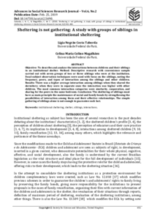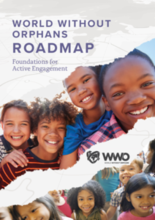Displaying 221 - 230 of 744
To ensure protection of children from institutional abuse, there is an urgent need to review the existing laws in terms of their efficacy to protect children and feasibility in implementation. The present study suggests possible solutions, by trying to understand standardized and effective models of care systems and mechanisms.
The purpose of this paper is to describe and analyze the interactions between children and their siblings in an institutional shelter in Brazil.
The current study compared behavioral and adrenocortical functioning of maltreated and comparably aged (1.5–3 years) institutionally-reared children soon after (1.5–2.5 months) placement in foster care or adoptive homes, respectively.
This article examines the aftercare experiences of young people who have recently left a residential care institution in Lagos State, Nigeria.
The question addressed in this paper from the Neural Plasticity journal is what happens to brain and behavior when a young child is deprived of key experiences during critical periods of brain development.
The current study examined longitudinal trajectories of memory and executive functioning (EF) from childhood to adolescence in the Bucharest Early Intervention Project, a randomized controlled trial of foster care for institutionally reared children in Romania.
This study used magnetic resonance imaging to compare adolescent AIDS orphans reared in institutions with a sex- and age-matched group of healthy adolescents reared in families in China using a voxel-based morphometry analysis.
In this paper, the authors advance a framework for examining the nature and consequences of neglect, which they posit can be represented as variations along a continuum from severe psychosocial neglect to environmental enrichment.
World Without Orphans Roadmap: Foundations for Active Engagement is a result of broadscale collaboration
among global, regional, and national leaders across many faith communities. It is informed by experts
from global organizations that lead the way in identifying best practices for caring for vulnerable families
and children.
This paper presents three care experienced perspectives on the benefits and challenges of capturing the voices of young people to inform policy and organisational decision-making in youth services.




